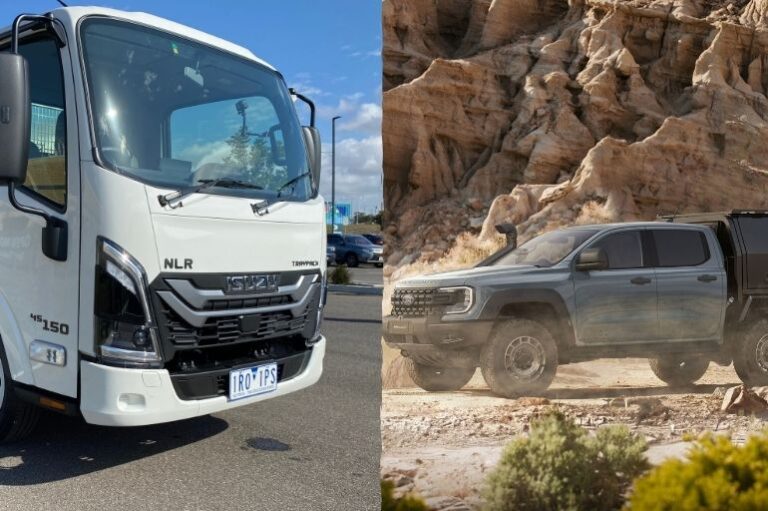For decades, Aussie truck operators have looked at utes as the cute little cousins of the commercial vehicle world. Good for runabouts and light work, sure—but not really built for serious payloads or all-day, every-day operation. But that mindset is about to get a major shake-up.
In April 2025, something big happened. Two giants in their respective segments—Ford and Isuzu Trucks—revealed new vehicles that are kicking down the walls between ute and light truck. And for truck operators who’ve always stuck with tried-and-tested cab-overs, this should be more than just interesting. It could change how you think about your next vehicle purchase.
Meet the Ford Ranger Super Duty: A Ute With Truck Credentials
Let’s start with Ford. The Ranger has been Australia’s top-selling vehicle for years, but now they’ve taken it to a whole new level with the upcoming Ranger Super Duty.
This isn’t just a dressed-up dual cab. It’s a ute built with 4,500kg GVM and 8,000kg GCM. That puts it squarely in the light truck performance bracket—but with the footprint, accessibility, and comfort of a ute.
Key features include:
- Bigger axles and chassis reinforcement
- Enlarged fuel tank for extended range
- Retains the Ranger’s familiar driving dynamics and cabin layout
- Standard safety tech carried over from the passenger market
If you’ve ever thought, “I wish my truck was as comfortable as a ute,” or “I wish my ute could carry more,” Ford has just thrown you the best of both worlds.
Isuzu Fires Back: A Truck That Drives Like a Ute
Not to be outdone, Isuzu Trucks has taken the opposite approach. Long regarded as the benchmark for small trucks in Australia, Isuzu is now injecting ute-like comfort and convenience into its light-duty range.
The new NLR and NKR models come equipped with:
- Front coil spring suspension for smoother ride quality
- Rack and pinion steering with a tighter turning circle than many SUVs
- ADAS safety features like adaptive cruise control and auto park brake
- Keyless entry and push-button start
- Car-like cabin comforts—without giving up the body strength and load ability of a proper truck
Even better, these vehicles still fall within car licence territory, which opens up hiring flexibility and reduces driver onboarding costs. If you’ve been struggling with licence class requirements or a shrinking pool of experienced truck drivers, that alone could be a game-changer.
Why Truck Operators Should Be Paying Attention
You might be asking: “Why would I consider a ute when I’ve always run trucks?” It’s a fair question—but here’s why this new convergence is worth a look:
- Driver Comfort and Retention
The more car-like and easy-to-drive a vehicle is, the better the experience for your team. These new platforms offer a quieter, smoother, and more tech-savvy experience than traditional trucks. - Smaller Footprint, Same Muscle
For urban and metro work, a truck chassis can be overkill—and difficult to park or navigate in tight areas. These next-gen utes offer the payload and towing capacity you need, with a footprint that fits underground car parks and suburban driveways. - Car Licence Access
Reduce dependency on truck-licenced drivers and widen your talent pool. - Safety First
Chain of Responsibility laws are only getting tighter. Vehicles that come with advanced safety systems and tech can help you meet your WHS obligations with less retrofit hassle. - Lower Operating Costs
Utes generally cost less to service and register than trucks. If you can get the capability you need without the full truck setup, that’s a potential win for your bottom line.
The Ute That Replaces a Truck, or the Truck That Feels Like a Ute?
This isn’t a shift about replacing your entire truck fleet with utes. It’s about recognising that fit-for-purpose now includes some very capable options in body styles you might not have previously considered.
Maybe your 3-tonne tipper jobs are still best served by your N-Series or Canter. But what about the service tech who only needs tools and a few parts? Or the mobile supervisor who wants to tow a trailer but doesn’t want to drive a cab-over? Or your metro delivery crew who are sick of shoulder soreness from bouncing around in a stiff leaf-spring cabin?
Suddenly, a Ford Ranger Super Duty or an Isuzu NLR with ute-level steering and comfort starts to look like the smart choice—not a compromise.
When and What to Watch For
Ford’s Ranger Super Duty is expected to launch in 2026, while Isuzu is already rolling out its new models between July and November 2025. Much of this rollout has been driven by updated ADR and Euro 6 requirements, which means you’re getting cutting-edge safety and emissions compliance out of the box.
Both Ford and Isuzu are bringing years of reliability and service support to the table, so you’re not taking a risk with an unknown brand. You’re simply getting more options—real, viable alternatives for how you build and manage your fleet.
Final Word: Time to Rethink What You Drive
The walls are coming down. The vehicles we once saw as strictly “ute” or “truck” are blending into something new. And for truck operators, that means greater flexibility without giving up the things that matter most: load capacity, reliability, safety, and total cost of ownership.
So before you put in that next truck order, maybe take a second look at what’s happening in the ute world. Because it’s not just tray backs and roof racks anymore. It’s serious business.
And 2026? That’s when the ute-truck war kicks off for real. Don’t be late to the party.






